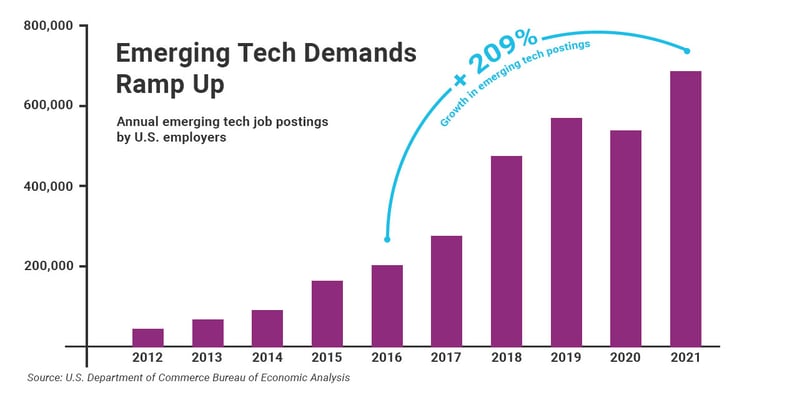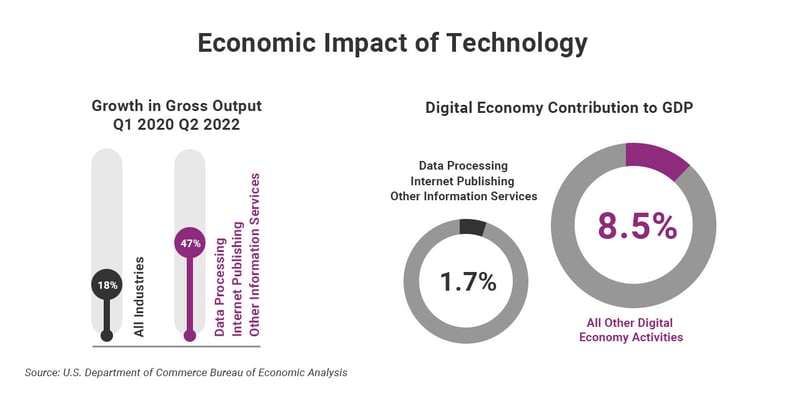January 7, 2025
Tech Talent Series Part 1: How the Tech Talent Shortage Could Derail Your Plans for Emerging Tech
Written by: Accelerance Research Team
The threat of budget cuts in IT departments remains a distinct possibility in the coming months as economic conditions deteriorate - but it isn’t the key factor keeping IT leaders awake at night.
According to numerous surveys of IT decision makers, finding and retaining tech talent trumps all other concerns by a large margin. We are still in the midst of a crippling skills shortage, one that is expected to act as a barrier to digital transformation all over the world for the rest of the decade.
That’s despite headlines announcing mass job losses at Silicon Valley tech companies. A Gartner analysis last month confirmed that insiders know - the companies responsible for the 10 largest layoffs, Amazon, Microsoft and Meta among them, employ 150,000 more people in total than they did at the start of 2020.
“It’s critical that business and IT leaders do not misinterpret this current wave of layoffs,” says Mbula Schoen, Senior Director Analyst at Gartner.
“There will likely be more swings and volatility as the market works its way through economic turbulence, ongoing pandemic adjustments and a shift in prioritization of skills. However, the tech talent crunch will continue long after current turbulence has subsided.”
The Same Problem… Virtually Everywhere
The reality, not just in pure tech companies, but in organizations that employ technology as a key business enabler, is that competition for skilled tech workers remains intense and will only grow. IDC Research estimates the global shortage of software developers alone will reach 4 million by 2025.
Failing to secure the right talent can have a crippling impact on efforts to modernize and build out new computer infrastructure and platform services, networks and cybersecurity, the digital workplace, and storage and database systems.
But it is most pronounced in the area of emerging technologies - artificial intelligence (AI), Internet of Things (IoT), metaverse, robotics and decentralized ledger (Web3) technologies. In those categories the tech talent pool is even shallower.
But Innovation Won’t Wait!
The Computer Industry Association (CompTIA) tracks job postings for tech-related roles and has identified an upward trend in hiring for new areas of technology.
That’s because businesses can’t afford to slow their pace of innovation and adoption of new technologies, given the imperative to develop compelling new products and services, achieve operational efficiencies and gain a competitive advantage over rivals.
“The workforce issue is perennial, but critically important,” CompTIA notes.
“As companies jockey against competition, they will need to up their game by hiring employees skilled in job roles in demand, such as those in data, cybersecurity and emerging trends. Software acumen, specifically development skills, will also play a larger role in the channel’s typical talent needs in 2023.”
Cloudflare’s Senior Vice President, Janet Van Huysse says the tech talent shortage is indicative of the “critical skills gap that exists in most industries today.”
“Not enough people within an organization have the skills that are necessary for business growth in the modern age," she says.
The Damage Done
Given the central role of technology to economic activity, the tech talent shortage represents a very tangible problem. The type of activities that fall into the IT category accounted for 1.7% of GDP in 2021, but also enabled a digital economy that represented a further 8.5% of GDP. The IT category is growing at 47% year on year, the highest rate of all business categories.

But the shortage of qualified and experienced tech talent threatens all of that by:
Slowing development: Project timelines stretch out as teams remain understaffed with key roles going unfilled. That’s a threat to the integrity of existing infrastructure that needs upgrading, let alone shiny additional projects that could result in new lines of business.
Raising costs: businesses are having to pay eye-watering rates to get developers onboard and the time to hire is blowing out to beyond 35 days. In-house development teams are more expensive than ever to run and with the US having a particularly high attrition rate among software developers, many businesses find themselves on a treadmill of constantly having to replace employees.
Limiting innovation: Demand for tech workers in areas like Web3 and Metaverse is growing by 300 - 400% per year, but a constrained supply of skilled workers threatens the development of these emerging tech categories, ultimately stifling innovation.
Stubborn Skills Shortages - What’s The Answer?
The domestic talent pipeline isn’t going to meet the needs of businesses hungry for tech workers anytime soon. So it comes down to optimizing your HR efforts to make your firm more attractive than the others competing for talent.
Here are five strategies you can use to help combat the tech talent shortage:
- Invest in training and development: One way to address the tech talent shortage is to upskill and reskill the people you already have. Mentorship and coaching programs are becoming more widely established as employers look within their own ranks to meet talent shortages.
- Partner with universities and other educational institutions: Businesses can also partner with universities and other educational institutions to develop internship and graduate programs. These programs can help businesses identify and attract talented students and recent graduates who may be interested in pursuing careers in emerging technologies like AI.
- Offer competitive compensation packages: To attract and retain top talent, you need to offer competitive compensation packages. This can include not only salary and benefits, but also opportunities for career advancement and professional development. Benchmarking your organization against industry rates will give you an idea of what you need to offer to secure the right talent.
- Build a strong employer brand: Become the company that every developer wants to work for, allowing you to attract top talent in the process. It helps if you are creating exciting, game-changing products. But many tech workers are also seeking out employers that align with their values. By showcasing your company's mission, values, and culture, and highlighting the impact that employees can have on the company's success, you can increase your attractiveness in a tight labor market.
- Think differently about hiring: There are outsourcing firms all over the world with specialist expertise in emerging technologies such as AI, IoT, Web3, and robotics. They can offer the developer capacity and expertise you need to build emerging technology platforms that you are struggling to assemble in-house.
With domestic talent shortages and lingering issues around securing tech worker visas, American companies are looking to software outsourcing to meet their talent needs. While outsourcing has typically been associated with the desire to lower labor costs, the reality in 2023 is that tech outsourcing companies from Croatia to Costa Rica are being drawn on to supplement software teams employing emerging technologies to answer business problems.
Recently Published Articles
View All Posts
Blog
January 16, 2025 | Accelerance Research Team
Tech Talent Shortage Part 2: Five Cutting-Edge Technologies to Adopt
Blog
May 1, 2024 | Rich Wanden
Guidelines for Choosing the Right IT Staff Augmentation Company
Knowledge
June 7, 2022 | Lisa Morrell
Don’t Panic: Making Sense of the Tech Slowdown Headlines
Subscribe to email updates
Stay up-to-date on what's happening at this blog and get additional content about the benefits of subscribing.


.png?width=300&name=Copy%20of%20WEBSITE%20Stop%20Chasing%20Low%20Hourly%20Rates%20Unlock%20the%20True%20Value%20of%20Offshore%20Development%20(450%20x%20253%20px).png)



